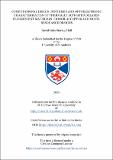Files in this item
Computational design, synthesis and optoelectronic characterisation of thermally activated delayed fluorescent materials : donor-acceptor and multi-resonance designs
Item metadata
| dc.contributor.advisor | Zysman-Colman, Eli | |
| dc.contributor.advisor | Olivier, Yoann | |
| dc.contributor.author | Hall, David Luke Starkey | |
| dc.coverage.spatial | 339 p. | en_US |
| dc.date.accessioned | 2022-04-29T11:48:57Z | |
| dc.date.available | 2022-04-29T11:48:57Z | |
| dc.date.issued | 2022-06-15 | |
| dc.identifier.uri | https://hdl.handle.net/10023/25261 | |
| dc.description.abstract | This thesis concerns the study of organic TADF materials, focussing on donor-acceptor (D-A TADF) and multi-resonance (MR-TADF) emitters. Materials were developed in silico, they were then synthesized, characterized and finally tested in OLED devices. Chapter 1 introduces the various radiative decay pathways available in electronically excited molecules from photoluminescence and electroluminescence. D-A TADF and MR-TADF emitters are discussed in detail. Chapter 2 introduces the background behind the computational methods undertaken. These include Hartree Fock, coupled cluster and DFT. Chapter 3 investigates the impact of donor dendrons in the TADF emitter 2CzPN. Donor extension improves kRISC but at the expense of increasing non-radiative pathways. Chapter 4 discloses a new acceptor unit, BImPy, which is coupled to phenoxazine as a donor, with TADF observed. The torsion angle within the acceptor was modulated as a function of N-substitution, with 4 emitters studied. In Chapter 5 a computational investigation of a series of 14 literature D-A TADF emitters is undertaken, with calculated T₁, T₂, S₁, ΔE[sub](ST), ΔE[sub](ST2) and ΔE[sub](T2T1) along with S₁, T₁ and T₂ excited state natures from DFT compared with SCS-CC2, with M06-2X and CAM-B3LYP performing well. Chapter 6 presents an accurate method for computational modelling of MR-TADF, SCS-CC2. This method is then used to design two new MR-TADF emitters which were synthesized and their optoelectronic properties evaluated with OLEDs fabricated. In Chapter 7 the calculated S₁, T₁ and ΔE[sub](ST) of 35 literature MR-TADF emitters from SCS-CC2 and TD(A)-DFT are compared with experimental values, with SCS-CC2 performing well. Using SCS-CC2 the properties of MR-TADF emitters are discussed and further studies of related INVEST materials and D-A emitters that contain a MR-TADF acceptors are undertaken. Chapter 8 presents a new class of MR-TADF emitter without acceptor units designed using SCS-CC2. Modest TADF in doped films and high performing hyperfluorescent OLEDs are presented. | en_US |
| dc.language.iso | en | en_US |
| dc.publisher | University of St Andrews | |
| dc.relation | Computational design, synthesis and optoelectronic characterisation of thermally activated delayed fluorescent materials - Donor acceptor and Multiresonance designs (thesis data) Hall, D., University of St Andrews, 23 Feb 2023 DOI: https://doi.org/10.17630/24d985e0-e808-413d-8877-d7b4204a6f6a | en |
| dc.relation.uri | https://doi.org/10.17630/24d985e0-e808-413d-8877-d7b4204a6f6a | |
| dc.rights | Creative Commons Attribution-NonCommercial-NoDerivatives 4.0 International | * |
| dc.rights.uri | http://creativecommons.org/licenses/by-nc-nd/4.0/ | * |
| dc.subject | Optoelectronics | en_US |
| dc.subject | TADF | en_US |
| dc.subject | Photophysics | en_US |
| dc.subject | Coupled cluster | en_US |
| dc.subject | DFT | en_US |
| dc.subject | Hyperfluorescence | en_US |
| dc.subject | MR-TADF | en_US |
| dc.subject | D-A TADF | en_US |
| dc.subject.lcc | TA1750.H26 | |
| dc.subject.lcsh | Optoelectronics | en |
| dc.title | Computational design, synthesis and optoelectronic characterisation of thermally activated delayed fluorescent materials : donor-acceptor and multi-resonance designs | en_US |
| dc.type | Thesis | en_US |
| dc.contributor.sponsor | Leverhulme Trust | en_US |
| dc.type.qualificationlevel | Doctoral | en_US |
| dc.type.qualificationname | PhD Doctor of Philosophy | en_US |
| dc.publisher.institution | The University of St Andrews | en_US |
| dc.publisher.department | Université de Mons | en_US |
| dc.rights.embargoreason | Embargo period has ended, thesis made available in accordance with University regulations. | en |
| dc.identifier.doi | https://doi.org/10.17630/sta/163 | |
| dc.identifier.grantnumber | RPG-2016-047 | en_US |
The following licence files are associated with this item:
This item appears in the following Collection(s)
Except where otherwise noted within the work, this item's licence for re-use is described as Creative Commons Attribution-NonCommercial-NoDerivatives 4.0 International
Items in the St Andrews Research Repository are protected by copyright, with all rights reserved, unless otherwise indicated.


